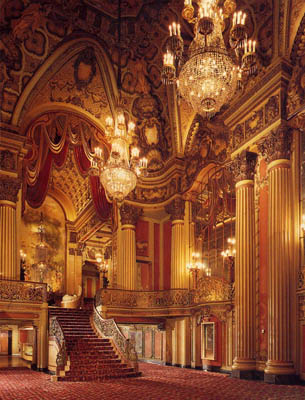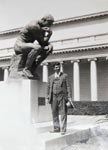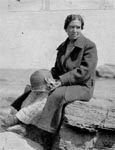Los Angeles
Under great duress, the Rivas family arrived in Los Angeles by train in September 1923, and soon settled into a home at 7th and Soto Street. Traveling with several large chests and all the luggage they could carry, they had stripped their artwork from the frames in Mexico, and rolled the canvases up tightly to transport as many as they could. Candelario carried his liquid savings in gold in a very heavy leather belt that he wore for the duration of the trip. The family had considered moving to Monterrey, Mexico, and then to New York City, but the presence in Los Angeles of exiled archbishops whom he knew probably brought the family to the City of the Angels.
Herlinda greatly missed her faithful servants and Mexican homeland, and she cried nightly for the first month. Candelario assured her that they would return in two years, but continuing assasinations of key Catholic leaders during the presidency of Plutarco Calles prevented the family from ever returning. Within two weeks, Herlinda gave birth to Carmen Gudelia, their last child, and Candelario started making connections with the archbishops he had known in Mexico. Candelario, Herlinda and the family had studied English with a British tutor in Salamanca, and believed that they would do reasonably well speaking the language in America. Instead, they understood next to nothing of the American English, and started from scratch to learn the new language.
Herlinda soon began to attend American cooking classes down the street, and with the birth of Carmen, Candelario brought a maid into the household to help with the everyday chores, though never to help with the children.
Work for the fine artist was different in the new country. Candelario had earned substantial commissions painting murals in the constant stream of new church decorations, and by painting many estate-style portraits for the well-to-do. There were many churches in Los Angeles, but only a fraction of the numbers in the central states of Mexico, and since the archdiocese had never developed a school of artists for their churches, the few churches being redecorated were not likely to be designed for large murals. And without the fame he had in Mexico, Candelario found it difficult to secure work painting portraits. So we know that within a few months of arriving in Los Angeles, Candelario passed up a chance to invest his money in land in the San Fernando Valley, and instead bought a photography studio right across the street from the Old Plaza Church in downtown Los Angeles. Within three years Candelario had moved his studio back to their house, during which time he continually looked for work as a painter of fine art.
His first break came when the Franciscan priests contracted him to paint several large murals for their new St. Joseph's Church in what is now the Garment District of Los Angeles. This provided Candelario good publicity, and within a few years he had a commission to render many individual paintings for the Old Plaza Church. Most unfortunately, both churches have been destroyed with fire and earthquake, and few photographs of the paintings remain.
Almost all of the religious art commissions that Candelario did manage to secure for himself were requests to replicate European classics, and thus we have but a few of his originals to show from this period.






